By Leen Randell
Updated: Jul 08, 2024
10 Best Herbal Decoctions For Insomnia
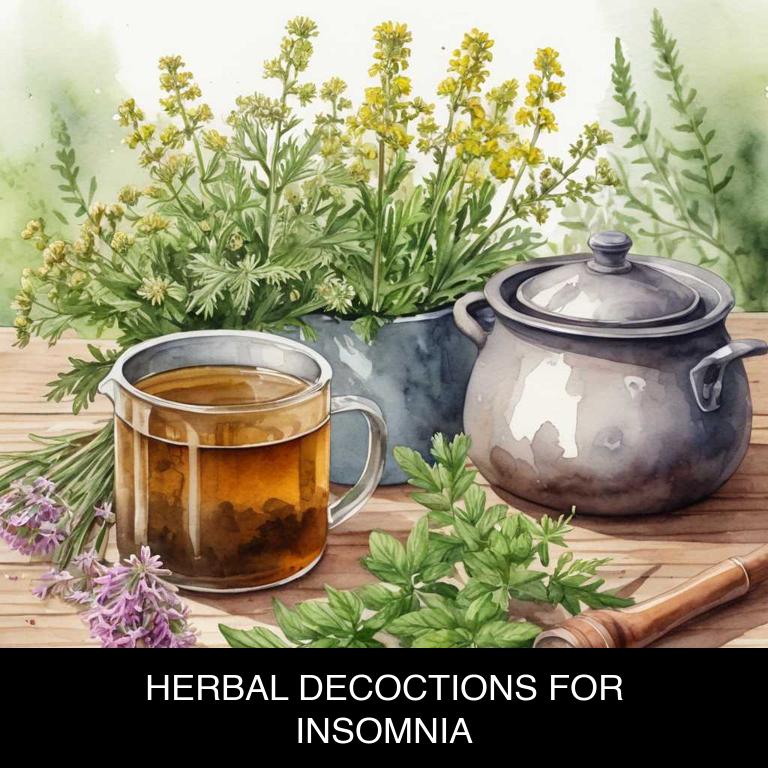
Herbal decoctions for insomnia are a natural remedy that involves steeping herbs in hot water to create a soothing tea that can help alleviate symptoms of insomnia.
These decoctions work by promoting relaxation, reducing stress and anxiety, and regulating sleep patterns. Examples of herbal decoctions that help with insomnia include valerian root, chamomile, and lavender. Drinking these teas before bed has been shown to improve the quality of sleep, increase the duration of sleep, and reduce the number of awakenings during the night.
This can lead to a more rested and refreshed morning, improved cognitive function, and overall better mental health.
The following article describes in detail the most important decoctions for insomnia, including medicinal properties, parts of herbs to use, and recipes for preparations.
- 1. Valeriana officinalis
- 2. Lavandula angustifolia
- 3. Passiflora incarnata
- 4. Melissa officinalis
- 5. Ginkgo biloba
- 6. Crataegus monogyna
- 7. Sambucus nigra
- 8. Humulus lupulus
- 9. Piper methysticum
- 10. Centella asiatica
- What is the best combination of herbal decoctions to use for insomnia?
- What ailments similar to insomnia are treated with herbal decoctions?
1. Valeriana officinalis
Valerian decoctions helps with insomnia because they promote relaxation, reduce anxiety and stress levels, and regulate sleep patterns.
The valerenic acids present in the root of the plant have a calming effect on the nervous system, soothing the mind and body. As a result, herbal valerian decoctions can help individuals fall asleep faster, stay asleep longer, and wake up feeling refreshed and rejuvenated.
Regular consumption of valerian decoctions also improves sleep quality, making it an effective natural remedy for insomnia sufferers.
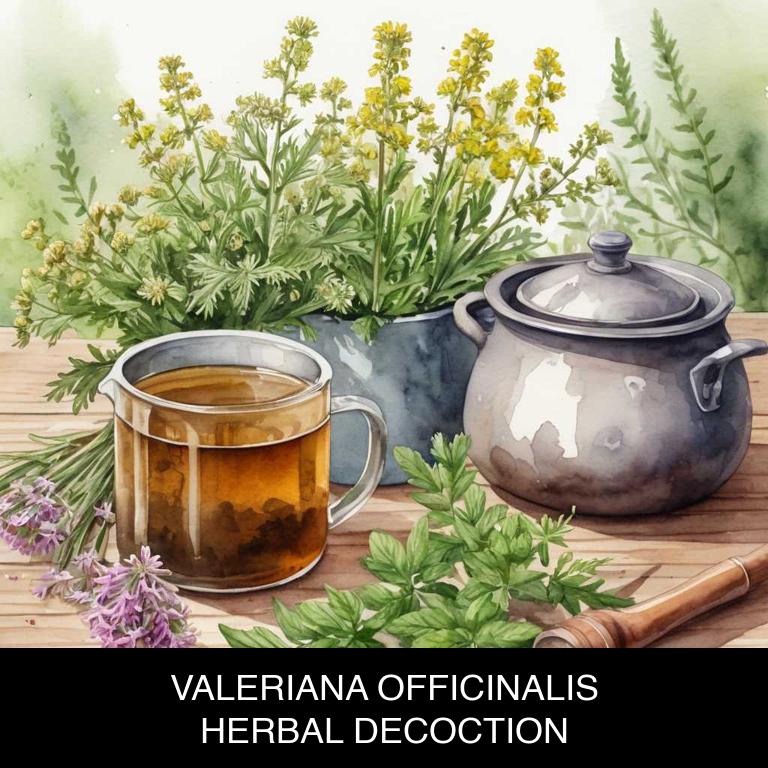
Medicinal Constituents
The list below shows the primary medicinal constituents in Valeriana officinalis decoctions that help with insomnia.
- Valerenic acid: This sesquiterpene acts on the GABA (gamma-aminobutyric acid) receptors in the brain, promoting relaxation and reducing anxiety to help alleviate insomnia.
- Isovaleric acid: This organic acid has sedative and anxiolytic properties, which contribute to its sleep-promoting effects by reducing stress and promoting a state of relaxation.
- Valeranone: This sesquiterpene also acts on the GABA receptors, similar to valerenic acid, and has been shown to have sedative and anxiolytic effects, helping to improve sleep quality and duration.
Parts Used
The list below shows the primary parts of valerian used to make decoctions for insomnia.
- Roots: The roots of Valeriana officinalis are primarily used to make decoctions for insomnia because they contain the highest concentration of valerenic acids, which have sedative properties.
- Leaves: The leaves are sometimes used, but less commonly, due to their lower valerenic acid content compared to the roots.
- Flowers: The flowers are occasionally used, especially in herbal teas, but they have a milder effect and are often used in combination with other parts.
Quick Recipe
The following recipe gives a procedure to make a basic valerian for insomnia.
- Gather 1 to 2 teaspoons of dried valeriana officinalis root and place it in a clean glass container.
- Combine the dried root with 1 cup of boiling water in a saucepan and stir gently.
- Steep the mixture for 5 to 10 minutes or until the desired flavor and aroma are achieved.
- Strain the liquid through a cheesecloth or a fine-mesh sieve into another container to remove the solids.
- Store the decoction in the refrigerator for up to 3 days or consume immediately after preparation.
2. Lavandula angustifolia
English lavender decoctions helps with insomnia because of its calming and soothing properties.
The subtle aroma of lavender can slow down a racing mind, promoting relaxation and reducing stress levels. As you sip on a warm decoction before bed, the gentle sweetness of the herb can calm your nervous system, making it easier to fall asleep and stay asleep throughout the night.
This natural remedy has been used for centuries to promote a restful night's sleep and wake up feeling refreshed and rejuvenated.
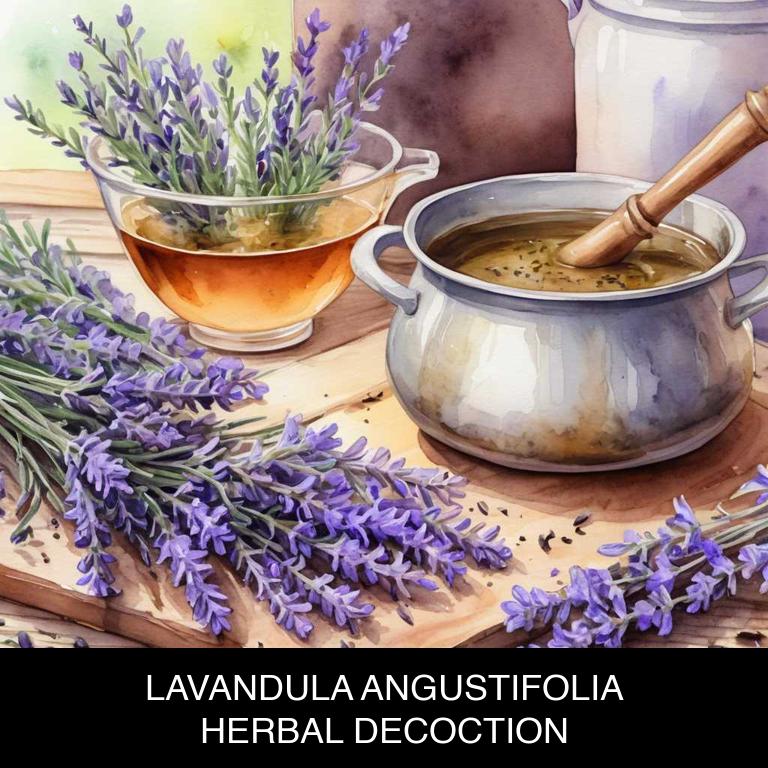
Medicinal Constituents
The list below shows the primary medicinal constituents in Lavandula angustifolia decoctions that help with insomnia.
- Linalool: A terpene that acts as a GABA receptor agonist, promoting relaxation and reducing anxiety to help with falling asleep.
- Linalyl acetate: A terpene that has a sedative effect, reducing stress and promoting a calm state, making it easier to fall asleep and stay asleep.
- Caffeic acid: A phenolic compound that has a calming effect, reducing inflammation and promoting relaxation, which can help alleviate symptoms of insomnia.
Parts Used
The list below shows the primary parts of english lavender used to make decoctions for insomnia.
- Leaves: They are used to make decoctions for insomnia because they contain calming compounds that help regulate sleep patterns.
- Flowers: They are used to make decoctions for insomnia because they contain calming essential oils that promote relaxation and reduce stress.
- Buds: They are used to make decoctions for insomnia because they contain high levels of calming compounds that help soothe the mind and body before sleep.
Quick Recipe
The following recipe gives a procedure to make a basic english lavender for insomnia.
- Gather 20g of dried lavandula angustifolia flowers in a clean container for decoction preparation.
- Combine the dried flowers with 250ml of boiling water in a heat-resistant glass bowl or pot.
- Steep the mixture for 5-7 minutes or until the liquid has reduced slightly and cooled slightly.
- Strain the decoction through a cheesecloth or a fine-mesh sieve into a clean glass container.
- Store the cooled decoction in a dark glass container in the refrigerator for up to 3 days.
3. Passiflora incarnata
Maypop decoctions helps with insomnia because they promote relaxation and calmness.
The herb contains flavonoids, which have a sedative effect on the nervous system, helping to quiet the mind and body. Additionally, maypop has been shown to increase GABA levels in the brain, a neurotransmitter that regulates sleep and relaxation.
As the decoction takes effect, users often report feeling more tranquil and rested, making it easier to fall asleep and stay asleep throughout the night.

Medicinal Constituents
The list below shows the primary medicinal constituents in Passiflora incarnata decoctions that help with insomnia.
- Harmane: Harmane is a beta-carboline alkaloid that acts as a GABA receptor agonist, helping to increase the activity of GABA, a neurotransmitter that promotes relaxation and reduces anxiety, thereby improving sleep quality.
- Isovitexin: Isovitexin is a flavonoid glycoside that has sedative and anxiolytic properties, helping to reduce stress and anxiety levels, making it easier to fall asleep and stay asleep throughout the night.
- Isophytol: Isophytol is a terpene that has been shown to have a sedative effect, likely due to its ability to bind to GABA receptors, promoting relaxation and reducing the symptoms of insomnia.
Parts Used
The list below shows the primary parts of maypop used to make decoctions for insomnia.
- Leaves: They are used due to their high content of passifloric acid and other flavonoids that have sedative properties.
- Roots: They contain a higher concentration of flavonoids and alkaloids, such as passiflorine, which help in inducing sleep.
- Fruits: The pulp and seeds of the fruit are used due to their rich content of passifloric acid and other flavonoids that promote relaxation and reduce insomnia.
Quick Recipe
The following recipe gives a procedure to make a basic maypop for insomnia.
- Harvest 25 grams of dried passiflora incarnata flowers and leaves for decoction preparation.
- Weigh and combine the dried flowers and leaves in a saucepan with 250 milliliters of water.
- Boil the mixture over high heat for 5 to 7 minutes or until the liquid reduces by half.
- Strain the decoction through a cheesecloth or fine mesh sieve into a clean container.
- Store the passiflora incarnata decoction in the refrigerator for up to 24 hours before use.
4. Melissa officinalis
Lemon balm decoctions helps with insomnia because of its calming effects on the mind and body.
The herb's active compounds, such as rosmarinic acid and citral, work together to promote relaxation and reduce stress levels. Drinking a warm lemon balm decoction before bed can help quiet the mind and slow down racing thoughts, making it easier to fall asleep and stay asleep throughout the night.
Additionally, lemon balm's sedative properties can also help regulate the body's natural sleep-wake cycle, allowing for a restful and rejuvenating sleep.
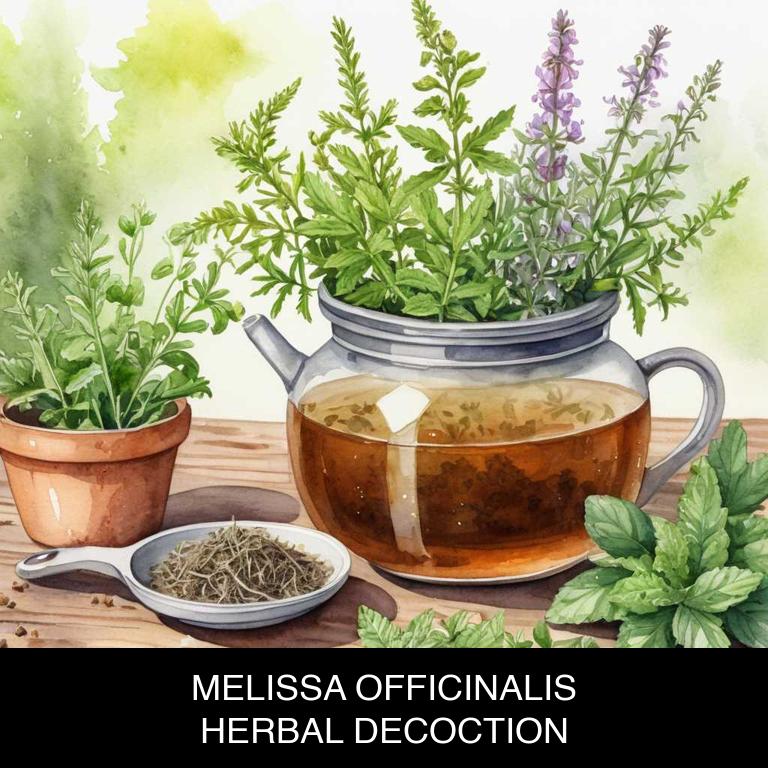
Medicinal Constituents
The list below shows the primary medicinal constituents in Melissa officinalis decoctions that help with insomnia.
- Rosmarinic acid: As a phenolic compound, rosmarinic acid has antioxidant and anti-inflammatory properties that help reduce stress and anxiety, making it easier to fall asleep.
- Linalool: A terpene with sedative properties, linalool helps regulate sleep patterns and promotes relaxation, reducing the likelihood of insomnia.
- Luteolin: A flavonoid with anxiolytic properties, luteolin helps alleviate anxiety and stress, which are common underlying causes of insomnia, making it easier to fall asleep and stay asleep.
Parts Used
The list below shows the primary parts of lemon balm used to make decoctions for insomnia.
- Leaves: Leaves are the most commonly used part of Melissa officinalis for insomnia due to their high content of essential oils, particularly linalool and linalyl acetate, which have a calming effect on the nervous system.
- Stems: Stems of Melissa officinalis are sometimes used in decoctions for insomnia, as they contain similar essential oils to the leaves, although in smaller amounts.
- Flowers: Flowers of Melissa officinalis are used in some decoctions for insomnia, as they have a mild sedative effect and are rich in essential oils, although their use is less common than the leaves and stems.
Quick Recipe
The following recipe gives a procedure to make a basic lemon balm for insomnia.
- Gather 1-2 teaspoons of dried melissa officinalis leaves or 3-4 grams of fresh leaves for decoction.
- Combine the gathered melissa officinalis with 1 quart of water in a saucepan and bring to a boil.
- Reduce the heat to a simmer and steep the mixture for 5-10 minutes to allow flavors to meld.
- Strain the decoction using a cheesecloth or fine-mesh sieve into a separate container to remove solids.
- Allow the decoction to cool to room temperature before transferring it to a storage container for later use.
5. Ginkgo biloba
Maidenhair tree decoctions helps with insomnia because it contains a unique combination of flavonoids, alkaloids, and saponins that work synergistically to promote relaxation and calmness.
The decoction's sedative properties help to slow down the nervous system, reducing feelings of anxiety and stress that often contribute to insomnia. Additionally, its ability to increase GABA production in the brain helps to regulate sleep patterns, allowing for a deeper and more restful sleep.
As a result, maidenhair tree decoctions can be a natural and effective remedy for individuals struggling with insomnia.

Medicinal Constituents
The list below shows the primary medicinal constituents in Ginkgo biloba decoctions that help with insomnia.
- Flavonoids: These plant-based compounds help alleviate insomnia by reducing inflammation and promoting relaxation in the brain.
- Bilobalide: A sesquiterpene trilactone found in Ginkgo biloba, bilobalide has a sedative effect on the nervous system, which can help individuals fall asleep and maintain a restful sleep.
- Quercetin: A flavonoid antioxidant, quercetin in Ginkgo biloba decoctions has anti-inflammatory properties, which can help reduce stress and anxiety that contribute to insomnia.
Parts Used
The list below shows the primary parts of maidenhair tree used to make decoctions for insomnia.
- Leaves: The leaves are commonly used to make decoctions for insomnia due to their high concentration of flavonoids and terpenoids, which have been shown to have a sedative effect.
- Roots: The roots are also used to make decoctions for insomnia, as they contain compounds that have been traditionally used to treat anxiety and promote relaxation.
- Seeds: The seeds of the Ginkgo biloba plant are occasionally used in decoctions for insomnia, although their use is less common than that of the leaves or roots, as they contain compounds that may help regulate sleep patterns.
Quick Recipe
The following recipe gives a procedure to make a basic maidenhair tree for insomnia.
- Measure out 0.5 to 1 gram of dried ginkgo biloba leaves per 8 ounces of water for a decoction.
- Combine the measured ginkgo biloba leaves with 8 ounces of water in a saucepan and bring to a boil.
- Reduce the heat to a simmer and allow the mixture to steep for 30 minutes to 1 hour.
- Strain the decoction through a cheesecloth or fine-mesh sieve into a clean container to remove solids.
- Store the herbal ginkgo biloba decoction in the refrigerator for up to 3 days and consume 1 to 2 cups as needed.
6. Crataegus monogyna
Hawthorn decoctions helps with insomnia because they promote relaxation and reduce anxiety, making it easier to fall asleep.
The flavonoids and polyphenols present in hawthorn have a calming effect on the nervous system, helping to quiet a racing mind and alleviate stress. Additionally, hawthorn's mild sedative properties can help regulate sleep patterns, leading to a deeper and more restful sleep.
By reducing symptoms of insomnia, hawthorn decoctions can improve overall sleep quality and leave individuals feeling refreshed and rejuvenated in the morning.
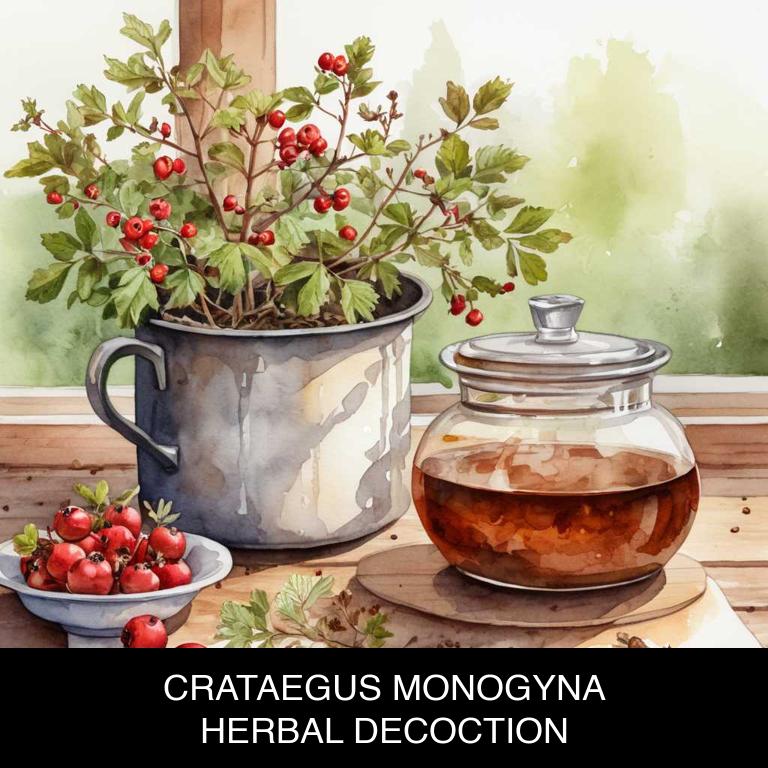
Medicinal Constituents
The list below shows the primary medicinal constituents in Crataegus monogyna decoctions that help with insomnia.
- Flavonoids: These plant compounds help with insomnia by promoting relaxation and reducing anxiety through their antioxidant and anti-inflammatory effects.
- Phenolic acids: Phenolic acids in Crataegus monogyna decoctions have sedative properties, which can help regulate sleep patterns and improve the quality of sleep.
- Flavonol glycosides: Flavonol glycosides, particularly quercetin, have been shown to possess sedative and anxiolytic effects, contributing to improved sleep quality and reduced insomnia.
Parts Used
The list below shows the primary parts of hawthorn used to make decoctions for insomnia.
- Leaves: They are used due to their sedative properties, helping to calm the mind and body.
- Fruits: They are used because they contain flavonoids, which have a soothing effect on the nervous system.
- Barks: They are used due to their calming properties, which help to reduce anxiety and promote relaxation.
Quick Recipe
The following recipe gives a procedure to make a basic hawthorn for insomnia.
- Gather 1 part of dried hawthorn berries and 2 parts of leaves and twigs of hawthorn.
- Crush 2 teaspoons of the mixture to release the active ingredients in a mortar.
- Combine the crushed mixture with 1 liter of water in a saucepan.
- Simmer the mixture for 10 to 15 minutes to create a decoction.
- Strain the decoction through a cheesecloth or a coffee filter to remove the solids.
7. Sambucus nigra
Elder decoctions helps with insomnia because its natural ingredients promote relaxation and calmness, making it easier to fall asleep.
The decoction's sedative properties work on the mind and body, calming racing thoughts and soothing physical tension. Additionally, elder decoctions can help regulate sleep patterns by promoting a restful and rejuvenating sleep.
As a result, individuals who consume elder decoctions regularly may experience improved sleep quality and duration, leading to better overall health and well-being.
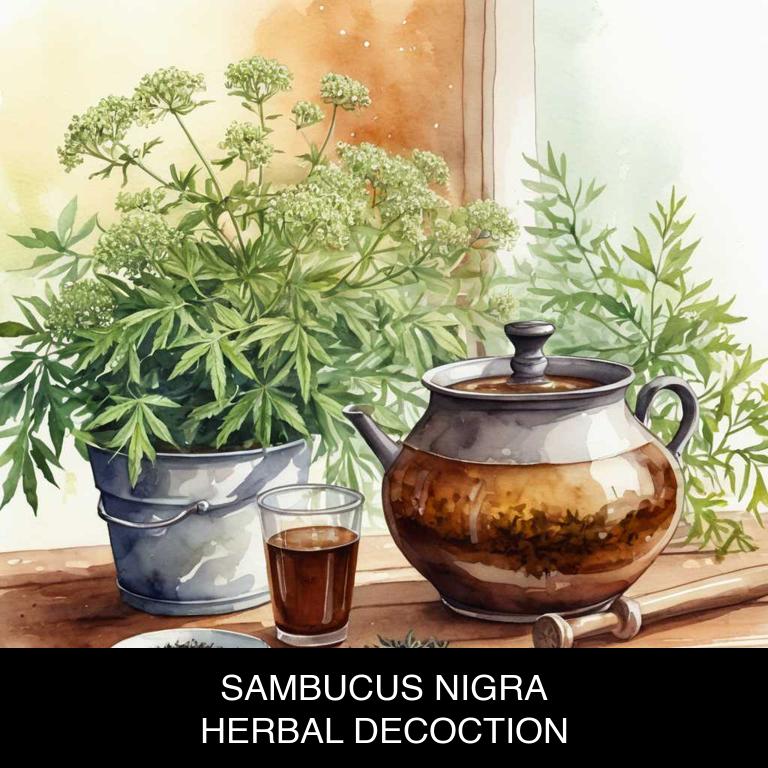
Medicinal Constituents
The list below shows the primary medicinal constituents in Sambucus nigra decoctions that help with insomnia.
- Flavonoids: These flavonoids have a sedative effect, helping to reduce anxiety and promote relaxation, ultimately aiding in better sleep.
- Phenylethanoid glycosides: These compounds have a sleep-promoting effect, contributing to improved sleep quality and duration by regulating the body's sleep-wake cycle.
- Phenolic acids: These compounds have a sedative and anxiolytic effect, helping to reduce stress and anxiety that can contribute to insomnia, promoting a restful night's sleep.
Parts Used
The list below shows the primary parts of elder used to make decoctions for insomnia.
- Flowers: They are rich in melatonin, a hormone that regulates sleep-wake cycles, making them effective in promoting relaxation and sleep.
- Stems: The stems contain flavonoids and glycosides, which have a sedative and calming effect on the nervous system, helping to induce sleep.
- Leaves: The leaves have a calming and soothing effect on the body, reducing anxiety and stress, which can contribute to insomnia, and promoting a restful sleep.
Quick Recipe
The following recipe gives a procedure to make a basic elder for insomnia.
- Harvest 25g of sambucus nigra berries from a trusted source in late summer or early autumn.
- Crush the berries into a fine powder using a mortar and pestle to release their medicinal properties.
- Combine the powdered berries with 500ml of water in a saucepan and bring to a boil.
- Reduce the heat and simmer the mixture for 10-15 minutes to extract the active compounds.
- Strain the decoction through a cheesecloth or fine mesh to remove the solids and discard the solids.
8. Humulus lupulus
Hops decoctions helps with insomnia because they contain flavonoids, which are natural sedatives that promote relaxation and reduce anxiety.
The alpha acids in hops also have a calming effect on the nervous system, making it easier to fall asleep. Additionally, hops decoctions have been shown to regulate sleep-wake cycles by increasing the production of melatonin, the hormone responsible for inducing sleepiness.
As a result, sipping on a warm herbal tea infused with hops before bed can help calm the mind and body, leading to a restful night's sleep.
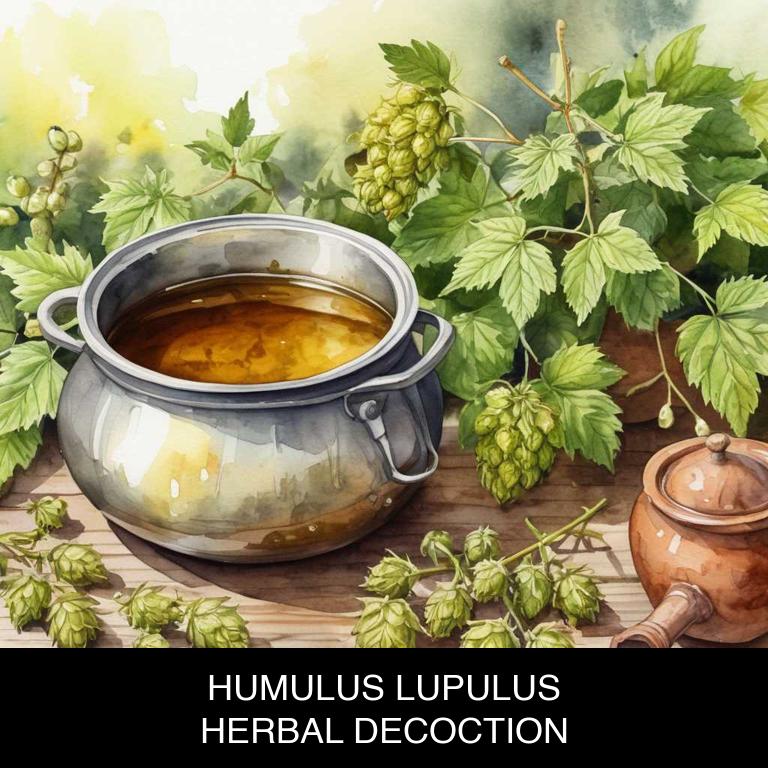
Medicinal Constituents
The list below shows the primary medicinal constituents in Humulus lupulus decoctions that help with insomnia.
- Lupulin: A type of sesquiterpene responsible for the sedative and anxiolytic effects in Humulus lupulus, which helps to reduce stress and promote relaxation.
- Humulone: A sesquiterpene that contributes to the sedative and hypnotic properties of Humulus lupulus, which helps to induce sleep and improve sleep quality.
- Xanthohumol: A prenylated flavonoid that exhibits antioxidant and sedative effects, which helps to reduce inflammation and promote relaxation, ultimately leading to improved sleep quality.
Parts Used
The list below shows the primary parts of hops used to make decoctions for insomnia.
- Flowers: The flowers of Humulus lupulus are commonly used due to their high content of essential oils and flavonoids, which have sedative properties.
- Stems: The stems of Humulus lupulus are used to make teas or decoctions that help promote relaxation and reduce anxiety, aiding in better sleep quality.
- Leaves: The leaves of Humulus lupulus are used for their calming effects, which can help reduce stress and promote a restful night's sleep.
Quick Recipe
The following recipe gives a procedure to make a basic hops for insomnia.
- Harvest 1 ounce of fresh or dried humulus lupulus flowers at the peak of flowering season for optimal potency.
- Crush the flowers into a fine powder to increase the surface area for efficient extraction.
- Combine 1 part powdered humulus lupulus with 4 parts water in a saucepan to create a decoction base.
- Bring the decoction base to a boil over medium heat then reduce the heat to a simmer for 10 minutes.
- Strain the decoction through a cheesecloth or a fine-mesh sieve to remove the solids and retain the liquid extract.
9. Piper methysticum
Kava decoctions helps with insomnia because of its unique ability to promote relaxation and calmness, making it easier for individuals to fall asleep.
The active compounds in kava, such as kavalactones, have been shown to interact with the brain's neurotransmitters, reducing anxiety and stress levels that often contribute to insomnia.
By soothing the nervous system, kava decoctions create a peaceful environment conducive to sleep, allowing individuals to drift off quickly and enjoy a restful night's sleep.
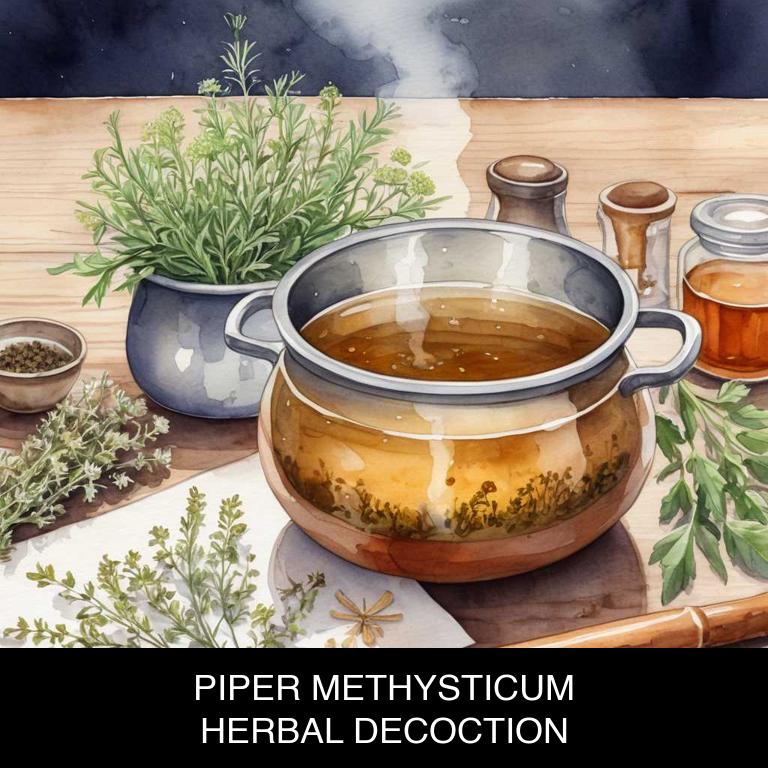
Medicinal Constituents
The list below shows the primary medicinal constituents in Piper methysticum decoctions that help with insomnia.
- Kavain: Kavain is an alkaloid that helps with insomnia by acting as a GABA receptor agonist, promoting relaxation and reducing anxiety, thus facilitating a good night's sleep.
- Yamamoto alkaloids: Yamamoto alkaloids, also known as kavalactones, help with insomnia by acting as a central nervous system depressant, reducing stress and anxiety levels, and promoting relaxation.
- Isoyastifoline: Isoyastifoline, a sesquiterpene alkaloid, helps with insomnia by acting as a sedative, reducing anxiety and stress levels, and promoting relaxation, which in turn helps with falling asleep and staying asleep.
Parts Used
The list below shows the primary parts of kava used to make decoctions for insomnia.
- Roots: The roots of Piper methysticum contain a high concentration of kavalactones, which are the active compounds responsible for its sedative and anxiolytic effects, making them effective for treating insomnia.
- Leaves: The leaves of Piper methysticum are also a rich source of kavalactones, which can be extracted to create decoctions that promote relaxation, reduce anxiety, and improve sleep quality.
Quick Recipe
The following recipe gives a procedure to make a basic kava for insomnia.
- Harvest 1-2 teaspoons of dried piper methysticum root from a trusted source.
- Crush the dried root into a fine powder to increase its surface area.
- Combine 1 teaspoon of the powdered root with 8 ounces of boiling water.
- Steep the mixture for 5-10 minutes to allow the active compounds to infuse.
- Strain the decoction through a cheesecloth or fine-mesh sieve into a cup.
10. Centella asiatica
Asiatic pennywort decoctions helps with insomnia because it possesses a unique combination of compounds that promote relaxation and calmness, making it easier to fall asleep.
The decoction's natural sedative properties help to reduce anxiety and stress levels, creating a peaceful atmosphere for the mind and body. Additionally, its adaptogenic qualities enable it to normalize sleep patterns, allowing individuals to wake up feeling refreshed and rejuvenated.
By addressing both physical and mental barriers to sleep, Asiatic pennywort decoctions offer a holistic approach to overcoming insomnia.
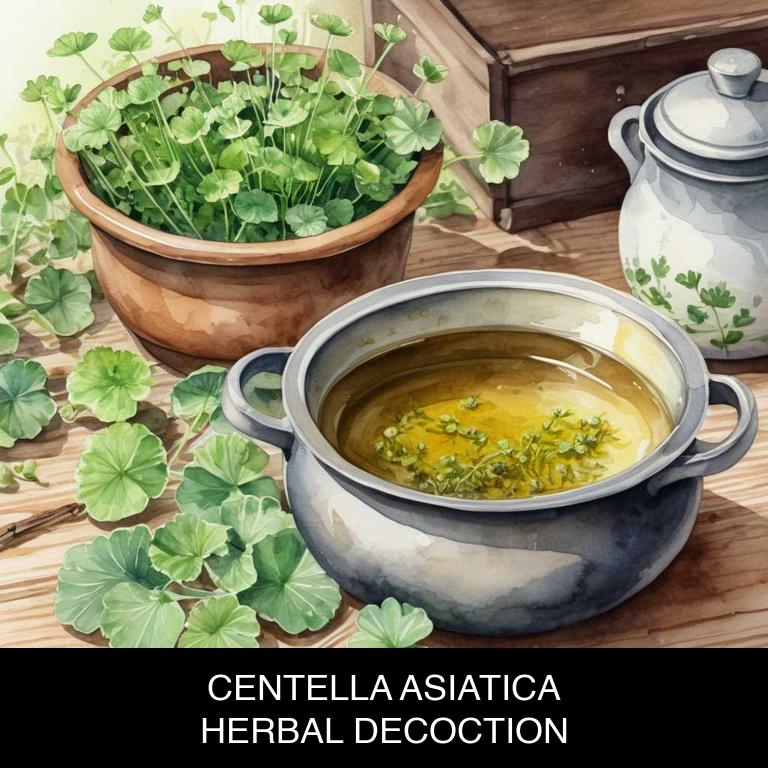
Medicinal Constituents
The list below shows the primary medicinal constituents in Centella asiatica decoctions that help with insomnia.
- Trigonelline: This alkaloid has sedative properties, helping to calm the nervous system and promote relaxation, which can aid in falling asleep and improving sleep quality.
- Asiatic acid: This triterpenoid saponin has anxiolytic (anxiety-reducing) effects, contributing to a sense of calmness and reducing stress-related insomnia.
- Madecassoside: This triterpenoid saponin has anti-inflammatory and neuroprotective properties, which can help reduce oxidative stress and inflammation in the brain, promoting a restful sleep environment.
Parts Used
The list below shows the primary parts of asiatic pennywort used to make decoctions for insomnia.
- Roots: They contain triterpenoid saponins, which have sedative and anxiolytic properties that help with falling asleep.
- Leaves: They contain flavonoids and alkaloids that have a calming effect on the nervous system, promoting relaxation and reducing insomnia.
- Barks: They contain flavonoids and triterpenoid saponins that have a soothing effect on the nervous system, helping to reduce stress and anxiety that may contribute to insomnia.
Quick Recipe
The following recipe gives a procedure to make a basic asiatic pennywort for insomnia.
- Gather 30-60 grams of fresh or dried centella asiatica leaves and stems, clean and free from contaminants.
- Combine the centella asiatica with 1 liter of water in a saucepan, bring to a boil over high heat.
- Reduce the heat to low and simmer the centella asiatica decoction for 10-15 minutes, stirring occasionally.
- Strain the decoction through a cheesecloth or fine-mesh sieve into a clean container, discard the solids.
- Allow the decoction to cool and store it in the refrigerator for up to 24 hours before consumption.
What is the best combination of herbal decoctions to use for insomnia?
The best combination of herbal decoctions that help with insomnia is a blend of lavender, chamomile, and valerian root.
Lavender promotes relaxation and calms the mind, while chamomile soothes the nervous system. Valerian root, rich in valerenic acid, has a sedative effect on the body, making it easier to fall asleep. Combine equal parts of dried lavender and chamomile flowers with valerian root, steep in boiling water, and drink 30 minutes before bedtime.
This soothing blend can help regulate sleep patterns and improve the quality of sleep.
What ailments similar to insomnia are treated with herbal decoctions?
Ailments similar to insomnia/decoctions.html">insomnia/decoctions.html">insomnia that are treated with herbal decoctions are anxiety, stress, and restlessness.
Decoctions made from herbs like valerian root, chamomile, and lavender can calm the mind and body, promoting relaxation and improving sleep quality.
Additionally, decoctions containing passionflower, skullcap, and kava can also help to alleviate symptoms of anxiety and panic attacks, making it easier to fall asleep and stay asleep throughout the night.